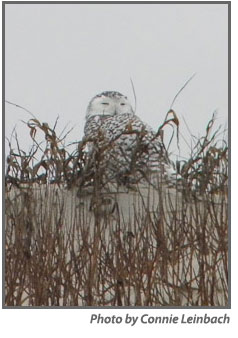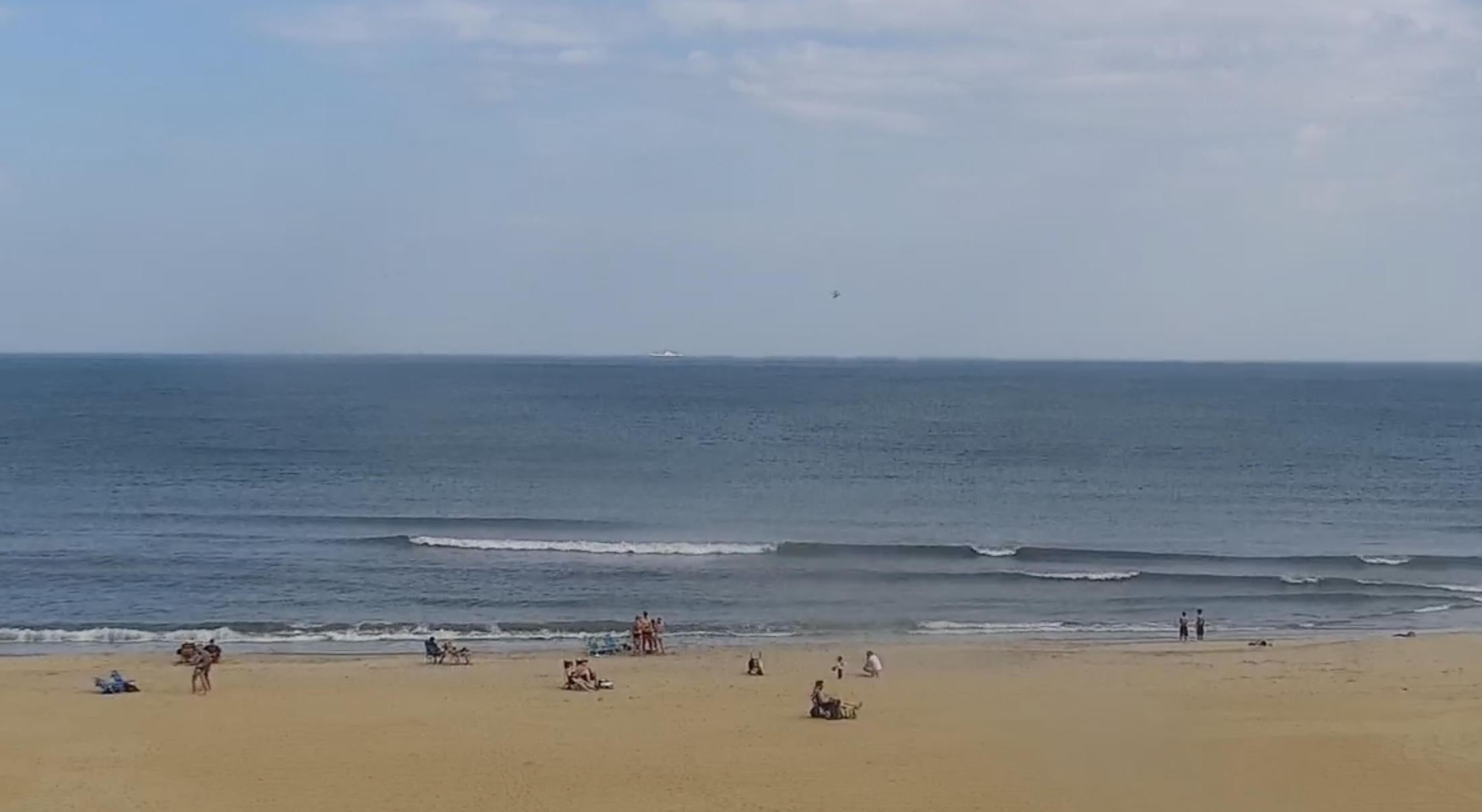Peter Vankevich has been a birding ambassador this winter for more than 100 visitors wanting to see the two rare snowy owls now calling Ocracoke their winter hunting grounds.
There may even be a third one, Vankevich says on a recent morning while driving his red Jeep on the South point beach where the owls have been seen most frequently.
He has gone out almost every day with folks since Jan. 4 to look for the owls, which typically plant themselves on the top of the dunes, constantly turning their heads 320 degrees in search of prey. Owls are night birds and most people hear them at night rather than see them, but snowy owls are out during the daylight.
“There’s just something about these snowy owls,” Vankevich says, with his ready smile and bubbling enthusiasm. “I call it the aesthetic of them on the dunes. Is there something more? I don’t know. Having these birds here is really unusual.”
His posts on his Facebook page prompted locals to drive with him for sightings. Then his posts on the “Carolina Birders” Facebook page prompted birders from all over the state and beyond to visit Ocracoke in the last several weeks, resulting in an uptick of winter tourists.
“More than 150 people have come so far,” he said on Sunday, Feb. 16, after shuttling about 20 visitors—the largest group yet–to the dunes between the airport ramp and South Point ramp where the owls have most often been spotted.
“One day I had 17 people and another day 14,” Vankevich says. “One man from Raleigh has seen 18 of the 19 species of North American owls and the last one he needed was the snowy. He left here with a bang because he saw and photographed both of them.
“With just a couple of exceptions, everyone who’s come here has seen it,” he says.
It didn’t take long for the Feb. 16 group to find one of the owls — the one Vankevich calls “Stanley.”
“This is truly amazing,” said Bob Oberfelder of Cary, as the group members got out their binoculars and telescopes. He had taken photos of a snowy owl more than 25 years ago in Delaware. When he heard about the snowy owls on Ocracoke, he decided to make the trip closer to home.
“When am I going to get to look at them closer to home than this?” he said.
That was the sentiment of most of the group.
Matthew Janson, 15, his brother Chris, 14, and their mom, Liz, traveled from Charlotte to see the bird. A ninth-grader, Matthew is an avid birder and already speaks with authority about the birds.
“These are all immatures because of the amount of black on their bodies,” he says after viewing the owl through his own scope.
Ken and Toni Blanton of Durham made it a birthday gift for Toni.
“I’ve been looking at pictures of the owl since December and have been making myself sick over it,” Toni said. “This is the best birthday ever.”
On the drive along U.S. 64 and Highway 12 a bald eagle flew in front of their car, and they saw tundra swans and snow geese on Pea Island. “It’s been a white bird weekend,” Toni said.
Vankevich gets as much of a kick making sure the birders have a memorable experience as the birders do in getting this chance to see a rare bird.
“A couple in their 70s came all the way from Asheville to see the owls,” he says. “I can’t tell you the joy they had from this.”
The first owl that was first seen Dec. 27 on the island is all white. According to the website www.eBird.org, it may be a male as males are all-white and females are darker.
However, that didn’t stop Vankevich, with the help of a group from Oriental, Pamlico County, to give these two names.
“Since the white one probably came from the northern Quebec area, I suggested we name it Blanche,”Vankevich says as he and a reporter drive along the South Point beach scanning the dunes. A Facebook conversation ensued, with someone suggesting the other one be named Stella (with apologies to “A Streetcar Named Desire”).
“No, I said, since the other one may be a male, let’s name it Stanley,” he says.
An amateur birder since his 20s, Vankevich, 60, is retired as head of the information section of the U.S. Copyright Office at the Library of Congress. His current job is manager of the Ocracoke Community Library. He also hosts a weekly music show on the island’s radio station WOVV, volunteers at the Ocracoke Preservation Society and—most important to him–is a volunteer with the Ocracoke Volunteer Fire Department. Vankevich also organizes the Christmas Bird Count each year on Ocracoke and Portsmouth.
A Maine native, Vankevich is a font of knowledge about birds, and most Friday mornings hosts a bird walk somewhere on the island. He also will send out tidbits of information to islanders, such as a recent e-mail explaining that the swirling flocks of birds everyone is seeing now are cedar waxwings that are munching on the cedar tree berries.
While driving the beach, he points out willets, sanderlings, Bonaparte’s gulls, great black-backed gulls and more. He counsels that term the “sandpiper” is out of date. Call them “shorebirds.” “Seagulls” are no longer called such and are simply referred to as “gulls”– because they can be seen as far inland as the Midwest, he says.
He stops to look at a great black-backed gull, which is the largest gull in the world, he says, almost the same size as a Bald Eagle.
The wanderings of the owls this far south is called an “irruption,” according to birders. Vankevich thinks the warmer Arctic weather produced more fledglings, which has put pressure on their food source, typically lemmings. So, the owls have simply ventured farther south for food territories. They eat “fur and feathers,” he says.
“From GPS tags, we have learned that they will go out in the ocean and grab ducks,” he says.
Owls are night birds, and most people hear them at night rather than see them, but snowy owls are out during the day because in the Arctic they have to adapt to many extremes, including times where there can be up to 24 hours of sunlight, Vankevich says. This year, they’ve been spotted as far south as Florida, he says. One even hopped a boat in North America and traveled to the Netherlands.
“They don’t like the wind,” Vankevich says about where to look for them. When it’s very windy, the owls can sometimes be found in the secondary dunes. They also have been spotted frequently at the shack at the end of the runway at the Ocracoke airport where they apparently roost.
“Owls are known to hang around airports,” Vankevich says. “They’re often found in the winter at Logan Airport (Boston).”
Elizabeth Hanrahan, a wildlife rehabilitation specialist who lives on the island, has been a part of the effort. She does not get paid for her work rehabilitating injured birds and wild animals, but when folks ask if they can pay Peter for his time, he has suggested they give donations to Hanrahan’s Ocracoke Wildlife Rehabilitation.
“Peter has done an outstanding job publicizing the owl and getting people to come to Ocracoke who’ve never been here,” she says. “I’m eternally grateful for the donations.”
Wayne Garrish, owner of the Bluff Shoals Motel, has had a few of the visiting birders stay at his establishment this winter. “We’ve definitely benefitted from the owl,” he says.
Betty Helen Chamberlain, co-owner of Captain’s Landing, also has noted the arrival of patrons who have come specifically to see the snowy owls, and Sean Death, manager of the Beachcomber campgrounds and gas station, has met many of the birders.
“It’s definitely helped business,” he says. “Every little bit helps at this time of the year.”
Hanrahan speculated that perhaps the appearance of the owls presaged the colder, snowy weather the island has had this year.
“Several years ago there was another irruption of snowy owls in the South, and after that we had a huge snow storm,” she says.
That might that be why owls are synonymous with wisdom, or something else other-worldly.
“They are prophecy birds,” says Sarah Klinger, who with her husband, Jeff, came to the island Sunday to see the owls. “This is just exciting to see.”
Birders wishing to see these owls might be wise to come soon to Ocracoke as Matthew Janson speculates that they might be gone by early March.
More information about the Snowy Owls can be found at the “eBird” website: http://ebird.org/content/ebird/news/gotsnowies2013.
CLICK HERE TO VIEW SLIDE SHOW


























